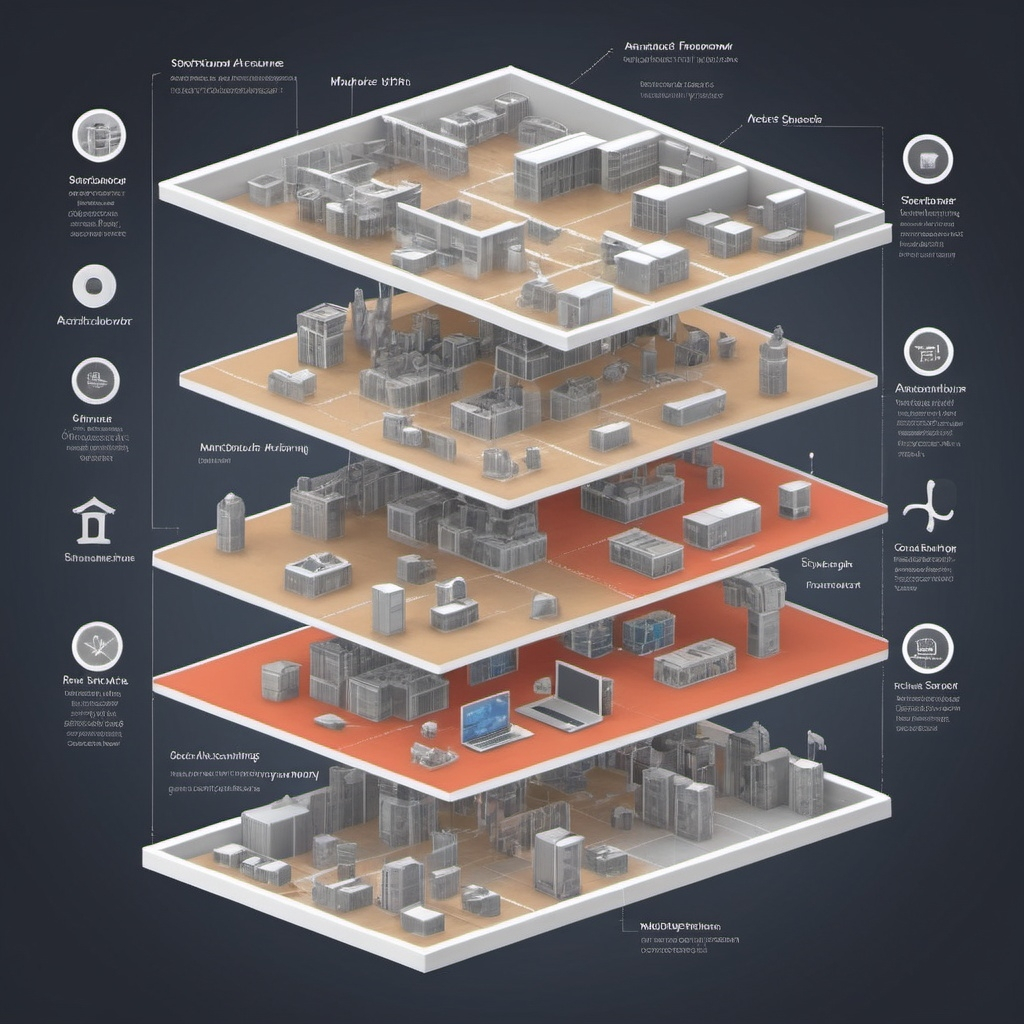A Practical Guide with Real-World Examples
In the dynamic and ever-evolving world of software development, creating robust, scalable, and efficient software systems is both an art and a science. At the heart of this process lies software architecture – a discipline that defines the structure and behavior of a system. Central to software architecture is the concept of a software architecture framework, which provides a foundational blueprint for building and maintaining complex software systems. Understanding and utilizing these frameworks is crucial for any software development project, ensuring that the end product is not only functional but also maintainable and scalable.
A software architecture framework acts as a roadmap for developers, guiding them through the design and implementation phases of a project. It encompasses a set of practices, principles, and guidelines that help in organizing the system’s components and their interactions. This structured approach not only streamlines the development process but also helps in mitigating risks and managing changes effectively. The framework ensures that all stakeholders, including developers, designers, and business analysts, have a shared understanding of the system’s architecture, which fosters better collaboration and communication.
In practical terms, a software architecture framework addresses various aspects of system design, such as the choice of technologies, design patterns, and the overall system structure. It provides a holistic view of the software, enabling developers to make informed decisions that align with the project’s goals and requirements. Moreover, it aids in identifying potential bottlenecks and performance issues early in the development cycle, thereby reducing the likelihood of costly rework and delays.
To illustrate the significance of software architecture frameworks, consider a realistic project scenario – developing an e-commerce platform. Such a project involves multiple components, including user interfaces, databases, payment gateways, and inventory management systems. A well-defined architecture framework will help in seamlessly integrating these components, ensuring that the platform is secure, scalable, and user-friendly. By adhering to the framework, developers can efficiently manage the complexities of the project, deliver high-quality software, and meet the expectations of end-users.
In this article, we will delve deeper into the concept of software architecture frameworks, exploring their key components, benefits, and practical applications. We will also examine a sample project to demonstrate how these frameworks can be effectively employed in real-world scenarios. Whether you are a seasoned developer or a newcomer to the field, this guide will provide valuable insights into the world of software architecture and help you leverage its potential in your projects.
What is a Software Architecture Framework?
A software architecture framework is a comprehensive set of practices, principles, and guidelines used to design and build software systems. It acts as a blueprint that outlines the overall structure of a system, including its components, interactions, and the technologies used. This framework helps in organizing and managing the complexities of software development, ensuring that the final product is robust, scalable, and maintainable.
Importance of designing an architecture framework
Software architecture plays a critical role in the software development process, serving as the foundational framework that guides the design, implementation, and maintenance of a software system. Its importance can be understood through various aspects that contribute to the success and quality of software projects. Here’s an in-depth look at why software architecture is essential in the software development process:
1. Provides a Clear Vision and Blueprint
Structure and Organization
Software architecture offers a structured approach to system design by defining the components, modules, and interactions within the system. This blueprint helps in organizing the development process, making it easier to manage and understand the system’s complexity.
Alignment with Business Goals
By defining a clear architecture, developers ensure that the software aligns with business objectives and requirements. This alignment helps in meeting stakeholder expectations and achieving project goals efficiently.
2. Enhances Communication and Collaboration
Common Understanding
A well-defined software architecture provides a common vocabulary and understanding among all stakeholders, including developers, designers, business analysts, and project managers. This common ground fosters better communication and collaboration, reducing misunderstandings and conflicts.
Documentation
Architectural documents serve as reference materials for the development team, ensuring that everyone is on the same page regarding the system’s structure and design decisions. This documentation is invaluable for onboarding new team members and maintaining the system over time.
3. Facilitates Scalability and Flexibility
Handling Growth
Good software architecture ensures that the system can scale to accommodate increasing user loads, data volume, and functional requirements. By designing for scalability from the outset, developers can avoid costly redesigns and performance issues in the future.
Adaptability to Change
Software architecture provides a framework for managing changes and incorporating new features or technologies. This flexibility is crucial in today’s fast-paced technological landscape, where requirements and technologies evolve rapidly.
4. Improves Quality and Maintainability
Modular Design
By breaking the system into modular components, software architecture promotes a clean and organized codebase. This modularity makes it easier to understand, test, and maintain the system, leading to higher quality software.
Error Reduction
A clear architecture helps in identifying potential design flaws and performance bottlenecks early in the development process. By addressing these issues proactively, developers can reduce the likelihood of bugs and errors, resulting in a more reliable system.
5. Enhances Performance and Efficiency
Optimized Resource Usage
Architectural decisions influence how resources, such as memory and processing power, are utilized. By optimizing these resources, software architecture can improve system performance and efficiency, ensuring a smooth user experience.
Load Distribution
In distributed systems, software architecture plays a key role in load balancing and fault tolerance. Proper architectural design ensures that the system can handle high loads and remain operational even in the face of component failures.
6. Supports Security and Compliance
Security Measures
Incorporating security principles into the software architecture ensures that the system is designed with security in mind. This includes implementing authentication, authorization, encryption, and other security measures to protect sensitive data and prevent unauthorized access.
Regulatory Compliance
Software architecture helps in ensuring that the system complies with relevant industry standards and regulations. By integrating compliance requirements into the architecture, developers can avoid legal issues and ensure that the software meets all necessary guidelines.
7. Facilitates Effective Risk Management
Identifying Risks Early
A well-defined architecture allows for the early identification of potential risks and challenges. By addressing these risks at the design stage, developers can mitigate their impact and reduce the likelihood of project delays or failures.
Contingency Planning
Software architecture enables the creation of contingency plans and fallback mechanisms, ensuring that the system can recover gracefully from unexpected issues. This proactive approach to risk management enhances the system’s robustness and reliability.
8. Enables Reusability and Standardization
Reusable Components
By designing reusable components and modules, software architecture promotes efficiency and reduces development time. These reusable elements can be leveraged across different projects, leading to faster development cycles and reduced costs.
Standard Practices
Adhering to architectural standards and best practices ensures consistency and quality across different projects. This standardization simplifies the development process and ensures that the software adheres to industry norms and expectations.

Practical Example: Developing an E-Commerce Platform
To illustrate the importance of software architecture, consider the development of an e-commerce platform. This project involves multiple components, including user interfaces, databases, payment gateways, and inventory management systems.
Clear Vision and Organization
A robust software architecture provides a clear blueprint for integrating these components, ensuring that the platform is secure, scalable, and user-friendly. By organizing the system into well-defined modules, developers can efficiently manage the complexities of the project.
Enhanced Collaboration
With a common understanding of the system’s architecture, all team members can collaborate effectively, reducing misunderstandings and enhancing productivity.
Scalability and Performance
Designing for scalability and performance ensures that the platform can handle increasing user loads and data volume, providing a smooth shopping experience for users.
Security and Compliance
Incorporating security measures into the architecture ensures that user data is protected, and the platform complies with relevant regulations.
Software architecture is a critical component of the software development process. It provides a structured approach to system design, ensuring that the software is scalable, maintainable, and aligned with business goals. By enhancing communication, managing risks, and optimizing performance, software architecture plays a pivotal role in the success and quality of software projects. Whether you are working on a small project or a large-scale enterprise system, understanding and leveraging software architecture is essential for achieving your development goals.
Key Components of a Software Architecture Framework
- Architectural Patterns: These are general, reusable solutions to common problems in software architecture. Examples include MVC (Model-View-Controller), Microservices, and Layered Architecture. These patterns provide a structured approach to organizing system components and their interactions.
- Design Principles: These are fundamental guidelines that influence the design and development of a system. Principles such as SOLID (Single Responsibility, Open-Closed, Liskov Substitution, Interface Segregation, and Dependency Inversion) help in creating systems that are modular, extensible, and easy to maintain.
- Technological Choices: This involves selecting the appropriate technologies, tools, and frameworks that best suit the project’s requirements. For instance, choosing between a relational or NoSQL database, selecting a front-end framework like React or Angular, or deciding on a backend language such as Java or Node.js.
- Non-Functional Requirements (NFRs): These are the system attributes that do not relate to specific functionality but are critical for the overall performance and user experience. Examples include scalability, security, performance, and usability.
- Documentation and Communication: Effective communication and comprehensive documentation are vital components of a software architecture framework. They ensure that all stakeholders have a clear understanding of the system’s design and can collaborate effectively throughout the development process.
Benefits of Using a Software Architecture Framework
- Consistency and Standardization: A framework provides a standardized approach to software development, ensuring consistency across different projects and teams. This standardization helps in reducing ambiguities and streamlining the development process.
- Improved Collaboration: With a clear architectural framework, all team members, including developers, designers, and business analysts, have a shared understanding of the system’s structure and goals. This fosters better collaboration and communication, leading to more efficient project execution.
- Risk Mitigation: By providing a structured approach to system design, a software architecture framework helps in identifying potential risks and issues early in the development cycle. This proactive approach minimizes the likelihood of costly rework and project delays.
- Scalability and Maintainability: A well-defined architecture framework ensures that the system is designed to handle future growth and changes. This scalability and maintainability are crucial for long-term success and adaptability to evolving business needs.
- Enhanced Quality: Adhering to best practices and design principles outlined in the framework results in higher quality software that meets user expectations and performs reliably under various conditions.

Practical Example: Developing an E-Commerce Platform
To better understand the application of a software architecture framework, let’s consider a sample project: developing an e-commerce platform. This platform will include features such as user registration, product listings, shopping cart, payment processing, and order management.
Step 1: Define Requirements
Before diving into the architecture, it’s essential to gather and define both functional and non-functional requirements. Functional requirements specify what the system should do, such as user authentication, product search, and payment processing. Non-functional requirements include aspects like performance, security, and scalability.
Step 2: Choose an Architectural Pattern
For our e-commerce platform, we can opt for a Microservices Architecture. This pattern involves breaking down the system into smaller, independent services that can be developed, deployed, and scaled separately. Each service will handle a specific business function, such as user management, product catalog, and order processing.
Step 3: Select Technologies
- Frontend: React for building a responsive and interactive user interface.
- Backend: Node.js for developing scalable and high-performance backend services.
- Database: MongoDB for handling product data, user information, and order details.
- Authentication: OAuth 2.0 for secure user authentication and authorization.
Step 4: Design the System
- User Service: Manages user registration, authentication, and profile management.
- Product Service: Handles product listings, search functionality, and inventory management.
- Cart Service: Manages the shopping cart, including adding, updating, and removing items.
- Order Service: Processes orders, including payment processing and order tracking.
- Payment Gateway: Integrates with external payment providers for secure transaction processing.
Step 5: Implement Non-Functional Requirements
- Scalability: Use containerization (Docker) and orchestration (Kubernetes) to deploy and scale services independently.
- Security: Implement HTTPS for secure communication, use JWT (JSON Web Tokens) for secure authentication, and ensure data encryption.
- Performance: Utilize caching mechanisms (e.g., Redis) to improve response times and reduce database load.
Step 6: Documentation and Communication
Create comprehensive documentation for the system’s architecture, including diagrams, API specifications, and deployment guides. Regularly communicate updates and changes to all stakeholders to ensure everyone is aligned and aware of the project’s progress.
Step 7: Testing and Deployment
Implement automated testing for each service to ensure functionality and performance meet the specified requirements. Use CI/CD pipelines to automate the deployment process, enabling frequent and reliable updates to the production environment.
Step 8: Monitoring and Maintenance
Once the platform is live, continuously monitor system performance, user activity, and error logs. Use monitoring tools like Prometheus and Grafana to gain insights into system health and address any issues promptly. Regularly update and maintain the system to ensure it remains secure, performant, and aligned with evolving business needs.

Conclusion
A software architecture framework is an essential tool for developing complex software systems. It provides a structured approach to system design, ensuring consistency, scalability, and maintainability. By understanding and applying these frameworks, developers can create robust and high-quality software that meets both functional and non-functional requirements.
In our example of developing an e-commerce platform, we demonstrated how to apply a software architecture framework from defining requirements to implementation and maintenance. By following these steps, developers can effectively manage the complexities of software development, deliver high-quality products, and meet the expectations of end-users.
Whether you are working on a small project or a large-scale enterprise system, leveraging a software architecture framework will help you navigate the challenges of software development and achieve success in your projects.
More for you





This was a fantastic read. Your analysis of the latest tech trends is spot on and very informative.